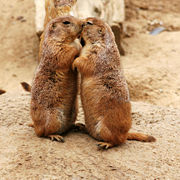Kiss

A kiss is the touching of one person's lips to another place, which is used as an expression of affection, respect, greeting, farewell, good luck, romantic affection or sexual desire. The word comes from Old English cyssan "to kiss", in turn from coss "a kiss".
Contents |
Biology and evolution

Anthropologists have not reached a consensus as to whether kissing is a learned or an instinctive behavior. Kissing may lead to sexual behaviors. It may be related to grooming behavior also seen between other animals, or arising as a result of mothers premasticating food for their children.[1]
Kissing allows prospective mates to smell and taste each other's pheromones for biological compatibility. Women are subconsciously more attracted to men whose major histocompatibility complex portion of their genome is different from their own, leading to offspring with resistance to a greater number of diseases due to heterosis, and thus having a better chance of survival.[2] [3] [4]
Non-human primates also exhibit kissing behavior.[5] Dogs, cats, birds and other animals display licking and grooming behavior among themselves, but also towards humans or other species. This is sometimes interpreted by observers as a type of kissing.
The anatomy of kissing
Kissing is a complex behavior that requires significant muscular coordination; a total of thirty-four facial muscles and 112 postural muscles are used during a kiss.[6][7] The most important muscle involved is the orbicularis oris muscle, which is used to pucker the lips and informally known as the kissing muscle. In the case of the French kiss, the tongue is also an important part. Lips have many nerve endings so they are sensitive to touch and bite.
Disease transmission
Diseases which may be transmitted through kissing include mononucleosis and herpes, when which the infectious organism is present in saliva. Research indicates that contraction of HIV via kissing is extremely unlikely, although a woman has been infected with HIV by kissing in 1997; both the woman and infected man had gum disease (so transmission was through the man's blood, not saliva).[8]
Kissing in Western culture


In modern Western culture, kissing is most commonly an expression of affection.[9] Between people of close acquaintance, a reciprocal kiss often is offered as a greeting or farewell.[10] This kind of kiss is typically made by brief contact of puckered lips to the skin of the cheek or no contact at all, and merely performed in the air near the cheek with the cheeks touching.[11] People may kiss children on the forehead to comfort them or the cheek to show affection, and vice versa.
As an expression of romantic affection or sexual desire in Western culture, kissing involves two people pressing their lips together with an intensity of sexual feeling. A couple may open their mouths, suck on each other's lips or move their tongues into each others' mouths (see French kiss). Romantic or sexual kissing may also involve kissing various parts of another's body (see Foreplay) such as the neck, the ears, the breasts, the navel, the genitals, etc.
In Eastern European countries and Slavic cultures until recent times, kissing between two men on the lips as a greeting or a farewell was not uncommon and not considered sexual.
Symbolic kissing is frequent in Western cultures. A kiss can be "blown" to another by kissing the fingertips and then blowing the fingertips, pointing them in the direction of the recipient. This is used to convey affection, usually when parting or when the partners are physically distant but can view each other. Blown kisses are also used when a person wishes to convey affection to a large crowd or audience. In written correspondence a kiss has been represented by the letter 'X' since at least 1763.[12] A stage or screen kiss may be performed by actually kissing, or faked by using the thumbs as a barrier for the lips and turning so the audience is unable to fully see the act.
Kissing in non-Western cultures

Some literatures suggest that a non-trivial percentage of humanity does not kiss.[13]
In Sub Saharan African, Asiatic, Native American and Polynesian cultures, kissing was relatively unknown until introduced by European and Western influence.[14]
With the Andamanese, kissing was only used as a sign of affection towards children and had no sexual undertones.[15]
Kissing in Muslim cultures is not widely accepted between two members of the opposite gender who are not married.
See also
- Air kiss
- Cheek kissing
- Eskimo kiss
- French kiss
- Hand-kissing
- Hand shaking
- Holy kiss
- Hugs
- Hugs and Kisses
- Judas Kiss
- Kissing games
- Kissing traditions
- Making out
Notes
- ↑ Premastication - Langmaker
- ↑ Santos, PS; Schinemann JA, Gabardo J, Bicalho Mda G. (2005). "New evidence that the MHC influences odor perception in humans: a study with 58 Southern Brazilian students.". Hormones & Behavior 47: 384–388. doi:. http://www.ncbi.nlm.nih.gov/entrez/query.fcgi?cmd=Retrieve&db=pubmed&dopt=Abstract&list_uids=15777804.
- ↑ Wedekind, C.; Seebeck, T., Bettens, F. and Paepke, A. J. (1995). "MHC-dependent mate preferences in humans". Proceedings: Biological Sciences 260 (1359): 245–249. doi:. http://links.jstor.org/sici?sici=0962-8452(19950622)260%3A1359%3C245%3AMMPIH%3E2.0.CO%3B2-Y.
- ↑ Fiore, Kristina (October 2, 2006). "Why do humans kiss?". Scienceline.
- ↑ "How animals kiss and make up", BBC News (October 13, 2003).
- ↑ Adrienne Blue (1996-06-01). "The kiss", The Independent (London). Retrieved on 2008-08-29.
- ↑ Roger Highfield (2006-10-17). "Seal with..146 muscles", The Telegraph. Retrieved on 2008-08-29.
- ↑ Case of H.I.V. Transmission Is First to Be Linked to Kiss - New York Times
- ↑ Larry James (2008-03-04). "The Romantic Kiss", The Zambian Chronicle. Retrieved on 2008-08-29.
- ↑ "Better Not Miss the Buss", The New York Times (2006-04-06). Retrieved on 2008-08-29.
- ↑ Marie Sophie Hahnsson. "Cheek Kissing". University of Oslo. Retrieved on 2008-08-29.
- ↑ "Oxford English Dictionary - X". Oxford University press (1999). Retrieved on 2007-02-01.
- ↑ Affairs of the Lips: Why We Kiss: Scientific American
- ↑ Keith Thomas (2005-06-11). "Put your sweet lips...". The Times. Retrieved on 2008-05-25.
- ↑ Chapter: 9: A Traditional Society
External links
- Put your sweet lips... (A history of the kiss), Keith Thomas, The Times, June 11, 2005
- The Kiss of Life, Joshua Foer, New York Times, February 14, 2006
- How Kissing Works, History and Anatomy of the Kiss, Tracy V. Wilson, Howstuffworks
- Kiss in the Street, Etienne Martin, StreetArt
- Scientific American Affairs of the Lips: Why We Kiss
- Famous Kisses From Judas to Spider-Man
- Wiki articles on how to Kiss and french kiss